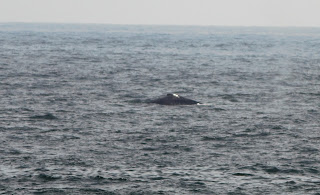 |
| Victorin's Scrub-Warbler |
Following
our visit to Kruger National Park and Johannesburg, we flew to Cape
Town, surely one of the world's finest cities. As usual, the imposing
Table Mountain behind a stunning coastline did not disappoint. We had
a nice apartment hired through Airbnb which overlooked the coast and
Robben Island. Our first day saw us up on the mountain summit courtesy of that draw-dropping cable car ride.
 |
| Table Mountain, from Cape Town waterfront |
 |
| Table Mountain, from summit |
Cape
Rock Hyrax was about the mountain top as usual.
 |
| Cape Rock Hyrax |
Our
second day had us pottering about the city after we couldn't get a
seat on a ferry to Robben Island. Day three and we headed south to
the Cape Peninsula, Cape of Good Hope and Cape Hope. The coastal
scenery was something to see and proteas and other wildflowers in the
fynbos were in full bloom everywhere we went. The region had been
suffering severe drought but we were fortunate because good
late-autumn rains had fallen, ensuring a bumper wildflower season.
 |
| Cape Hope |
 |
| Cape of Good Hope |
 |
| Cape Peninsula |
 |
| Proteas, Cape of Good Hope |
Nice
birds included Grey-backed Cisticola, Common Ostrich, Cape
Robin-Chat, Malachite Sunbird, Orange-breasted Sunbird and Cape
Cormorant.
 |
| Cape Cormorant |
 |
| Grey-backed Cisticola |
 |
| Malachite Sunbird |
 |
| Orange-breasted Sunbird |
 |
| Common Ostrich |
We
moved on to the pretty coastal village of Simonstown, where a small
colony of African Penguins is thriving.
 |
| African Penguin |
After
our Cape Town visit we headed east through Swellendam to check out
the Agulhas Plain on the road to Malaga, about 10 km south of the
highway. I was after two target birds – Cape (Agulhas) Clapper Lark
and Agulhas Long-billed Lark – and these were found without too
much trouble. Other birds included Red-capped Lark, Long-billed Pipit
and Sickle-winged Chat.
 |
| Cape Clapper Lark |
We
moved on to our accommodation for the next three nights – the
delightful Honeywood Lodge, our base for exploring the adjoining
Grootvadersbosch Nature Reserve in the Landeberg Range. We saw our first Blue Crane for the
trip on the way.
 |
| Our rooms at Honeywood Lodge |
 |
| View from Honeywood Lodge |
Birds
around the lodge included Cape Weaver, Lesser Honeyguide, Swee
Waxbill and Fiscal Flycatcher. I was pleased to see a Black Harrier
hawking the fields as we watched a stunning sunset from our lodge
verandah.
 |
| Cape Weaver |
 |
| Swee Waxbill |
On
our first morning at Honeywood we were in the fynbos above the
reserve. Here I tracked down a Victorin's Scrub-Warbler, a bird I'd
looked hard for without success during my last visit to the Cape. Later I heard one calling just below the lodge. We
moved down to the mosaic of tracks cut through the wet forest of the Grootvadersbosch Reserve, the westerly range limit for quite a few South African
birds. Here we found another bogey bird, Knysna Warbler. We ended up
hearing 5 or 6 birds over a couple of days and saw it three times,
including a good view, but the skulker refused to be photographed.
 |
| Grootvadersbosch Reserve - fynbos meets forest |
 |
| Grootvadersbosch Reserve forest |
Other birds in the forest on this and the following day included
Cape Batis, African Dusky Flycatcher, Sombre Greenbul, Red-chested
Cuckoo and Terrestial Brownbul. We saw Olive Woodpecker and then
finally had brief views of a Knysna Woodpecker, another target.
 |
| African Dusky Flycatcher |
 |
| Cape Batis |
 |
| Red-chested Cuckoo |
Birds
in more open areas around the lodge and park headquarters included
Brimstone Canary, Greater Striped Swallow Cape Canary and Olive
Thrush.
 |
| Brimstone Canary |

























































